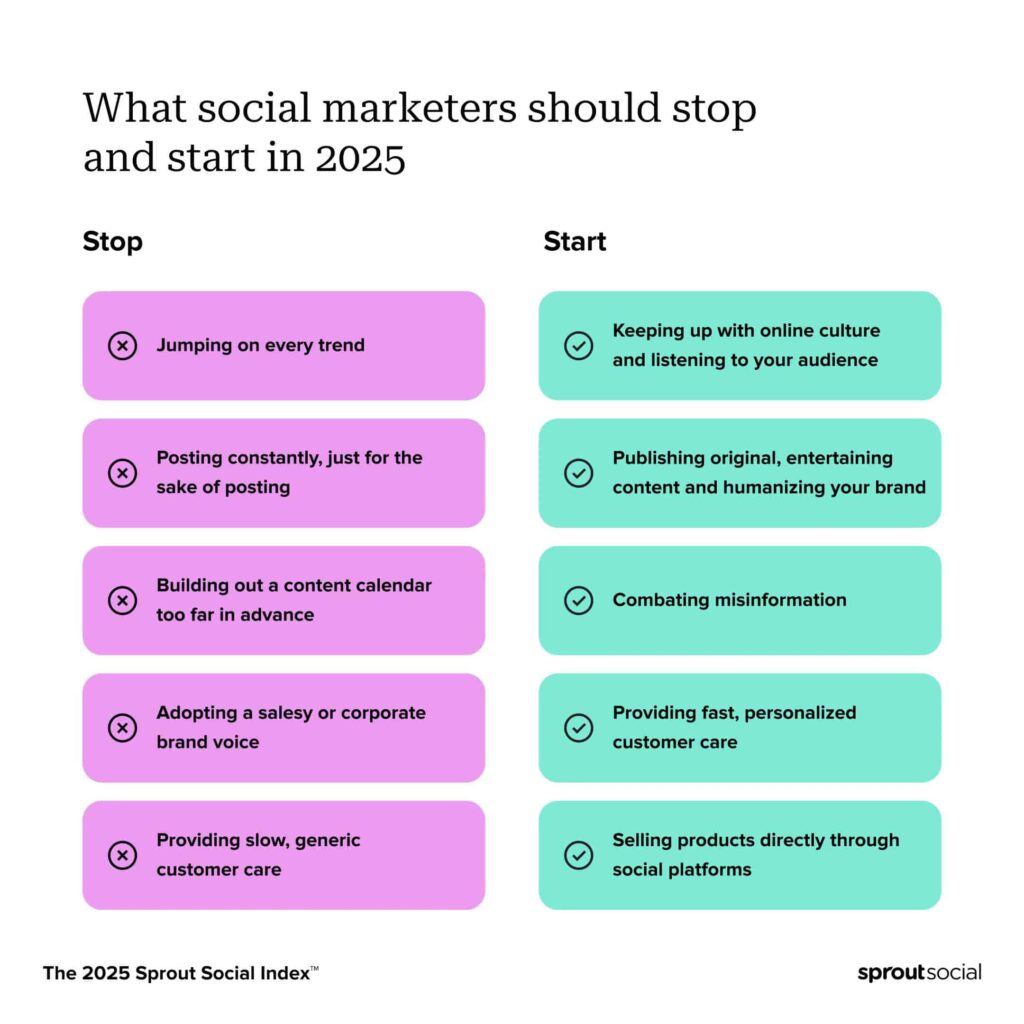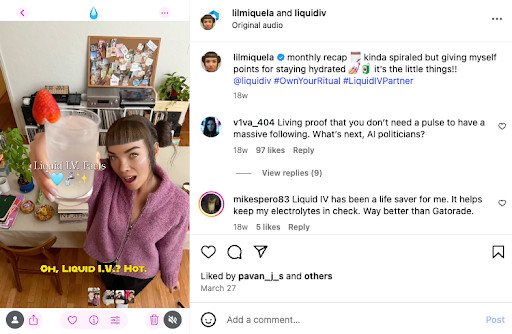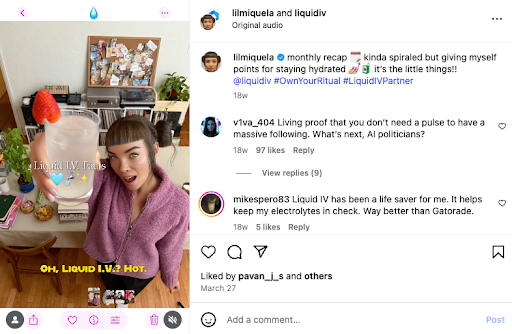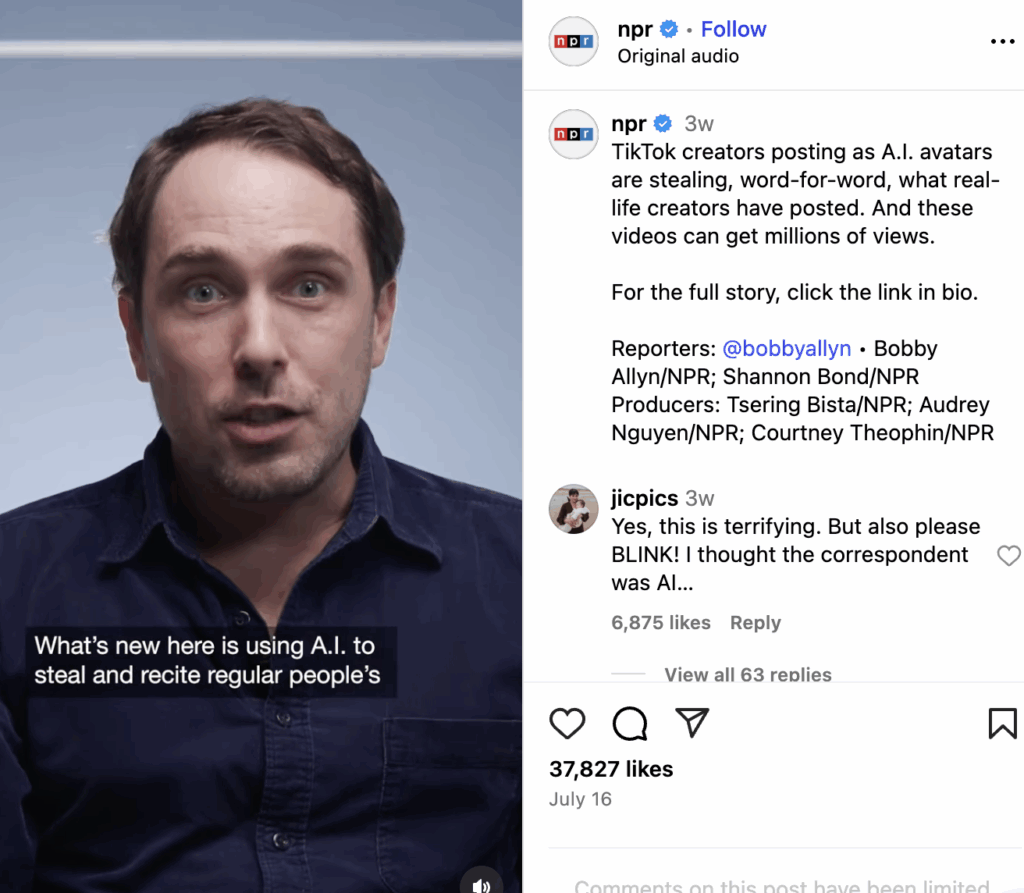The steady popularity of influencer marketing, coupled with rapid advancements in AI, fueled the growth of new social media personas: virtual influencers. These computer-generated personalities function a lot like real human influencers. They post selfies and content from their day-to-day lives alongside brand partnerships with major companies. But they don’t exist in the physical world.
More virtual influencers have flooded the scene since they first appeared on social, but are virtual influencers still a trend with staying power or more of a novelty for brands looking to cut through the noise of an increasingly crowded social media landscape? In this article, we’ll define virtual influencers and how they work, the major considerations brands should have before working with one and some of the most prominent virtual influencers on the scene today.
What are virtual influencers?
Virtual influencers are digital personalities that exist primarily on social media. They’re not real people but computer-generated characters created with advanced CGI, motion capture and AI technology.
There are different types of virtual influencers, ranging from non-human characters to highly realistic human-like personas. They’re often developed and managed by creative agencies specializing in AI, robotics or marketing. However, some brands have even created their own virtual influencers, like Brazilian retailer Magalu’s Lu. These brand-specific characters function more like spokesmodels or mascots, as they rarely have a platform or following outside of the brand.
How do virtual influencers work?
Virtual influencers operate much like regular social media influencers. These online avatars interact with social media users like human influencers, sharing content, endorsing products and engaging with followers. They offer a unique and innovative way for brands to connect with their audience. But there’s a core difference: The interactions they have with real-life products or services and the engagement with followers are completely fabricated.
A virtual influencer marketing example would be LiquidIV’s partnership with renowned AI influencer Lil Miquela. Miquela shared a reel highlighting her recent adventures, with special focus on how she incorporates LiquidIV into her routine. Like a typical influencer-brand partnership, Lil Miquela even disclosed the ad with hashtags like #LiquidIVPartner in the caption.
The benefits of virtual influencers
Influencer marketing and AI are two trends quickly taking over the marketing industry. In a Q3 2025 Sprout Social Pulse Survey about half of Millennials (48%) and more than half of Gen Z (53%) say they’ve bought a product or service through an influencer’s sponsored post in the last year. And, The 2025 Sprout Social Index™ found that 93% of social practitioners believe AI is a tool that can help creative fatigue. So what happens when you combine the two? Here are a few of the most significant benefits of partnering with virtual influencers.
Control over content
Brands who want to get across a certain message or have a specific point to make with an influencer partnership have a different level of control over content with virtual influencers. Having more control over what an influencer posts can be appealing to some brands with a very specific message to share.
Adaptability
Virtual influencers never age, can speak any language and can ‘travel’ to any place. This level of adaptability and flexibility means brands can potentially use one virtual influencer for campaigns in different regions instead of finding different influencers for various markets.
Consistency
Unlike human influencers whose brands might evolve as they age or enter different life phases, virtual influencers have a consistent appearance, personality and content. This stability means brands don’t have to worry about unexpected shifts and can rely on a virtual influencer to promote their offer in a predictable way.
What role will virtual influencers play in the creator economy?
The creator economy is constantly evolving, and virtual influencers are carving out a fascinating, yet complex, niche within it. Currently, consumer sentiment toward brands using AI influencers is mixed, with growing skepticism.
While Sprout’s 2024 Influencer Marketing Report showed that 37% of consumers might be more interested in a brand that uses an AI influencer, another 37% said they’d distrust the brand. And, Sprout’s Q3 2025 Pulse Survey data highlights rising concerns with AI influencers. Nearly half of consumers (46%) are uncomfortable with brands using AI influencers—with only 23% saying they’re comfortable.
With consumer sentiment on virtual influencers split, it’s up to brands to determine if these influencers have staying power. Virtual influencers can present a new frontier for creative expression in the creator economy, but their role will depend on how brands partner with them. Brands who want to explore virtual partnerships need to dispel consumer skepticism, prioritize transparency and focus on delivering unique, valuable content.
How virtual influencers can impact brands: Understanding the risks
While the virtual influencer market is growing—expected to reach nearly $45 billion USD by 2030 according to Grandview Research—brands and agencies are cautiously pursuing virtual influencer partnerships because they pose some risks.
Here are some key points brands need to think about as virtual influencers become more popular.
Bonus Resource: Get our top five AI social media marketing resources in one convenient toolkit. Download it for customizable templates and tips to drive smart AI adoption in your role and across your organization.
Brand safety and reputation
Virtual influencers may seem like a safer bet than real-life influencers, but they’re not completely immune to controversy. For example, influencer Caryn Marjorie made headlines for creating an AI version of herself that some people criticized for being demeaning to women and enabling anti-social behavior.
Additionally, AI has a black box problem. Humans don’t fully understand how these systems work or make decisions, which poses a huge challenge for advertisers and agencies. Without that clarity, it’s hard for brands to trust these virtual influencers completely. So, while AI has a cool factor, marketers must be careful about diving in headfirst to avoid future PR disasters.
Transparency and authenticity
A good portion of consumers already struggle to tell the difference between authentic and AI-generated content. A Sprout report on the Future of AI in Marketing found that more than a third of consumers (36%) say they wouldn’t be able to distinguish between AI and human-generated content. As technology advances and virtual influencers resemble humans even more, it’s imperative for brands to be transparent about how they use these tools.
The FTC said virtual influencers should disclose brand sponsorships just like human influencers, and the ad agency Ogilvy is pushing for clearer rules about AI-generated content. Still, virtual influencer regulations and guidelines are a work in progress.
Additionally, most brands work with influencers to tap into their authentic relationships with their audience. While there are still real people behind a virtual influencer, they can’t directly connect with their followers in the same way. They also can’t interact with products or give honest reviews like human influencers can, which can make their endorsements feel less genuine.
Audience sentiment
Virtual influencers can impact how people feel about brands—for better or worse. While AI tools have recently exploded in popularity and have dozens of benefits for marketers, the more human-like applications of the technology can sometimes produce an “uncanny valley” effect where people find them off-putting.
Some of the most popular virtual influencers also have racially ambiguous features, which marketing experts interpret as a way for brands to appeal to a broader audience. However, this approach could also work against a brand, as it can be seen as a shortcut to appearing more inclusive than they actually are—an issue many beauty and fashion brands have been criticized for.
Intellectual property misuse
Since virtual influencers are created using AI, their social presence relies on underlying digital assets, algorithms and data. Without understanding the agreements in place to source these assets, brands could inadvertently expose themselves to legal challenges or copyright infringement (i.e. were the AI models trained on copyrighted material without licensing?).
Real life examples of this have been surfacing across social networks, with AI creators stealing and reusing the content of human creators verbatim, without credit or acknowledgement.
Copycat content
In a crowded social media landscape, audiences crave originality. In addition to the legal risks that come with intellectual property misuse, partnering with the wrong virtual influencers has potential to dilute your brand voice with generic content pieced together from across the web. Consumers are tired of brands merely jumping on every trend and instead want to see brands that prioritize originality, relatability and genuine audience engagement, according to The Index.

A virtual influencer, if not managed with a strategic, human-centric approach, could fall into the trap of producing content that feels inauthentic, undermining a brand’s identity. To avoid this, brands need to make sure virtual influencer partnerships showcase content and stories that will resonate with their audience rather than follow a fleeting trend.
The top virtual influencers making waves on social media
The trend may be gaining momentum now, but virtual influencers have actually been around for quite some time, quietly revolutionizing the world of influencer marketing and building massive social media followings. From fashion icons to animated characters, here are the top virtual influencers to follow.
Lil Miquela
According to her Instagram bio, Miquela (@lilmiquela on Instagram) is a “19-year-old robot living in LA.” A pioneer in the virtual influencer space with 2.4 million Instagram followers and 3.4 million TikTok followers, she was launched in 2016 and is now managed by creative agency Brud. She’s partnered with brands like Prada, Pacsun and Calvin Klein and even earned a spot on TIME magazine’s list of the ‘25 most influential people on the internet.’
Imma
Imma (@imma.gram on Instagram) is a virtual girl in Tokyo with over 388k Instagram followers. The brainchild of Aww Inc., she’s known for her iconic bubblegum pink bob and killer sense of style. She is also curious and often questions her identity, using the hashtag #ithinkimcgi. Recently, Coach launched a campaign featuring Imma alongside celebs like Lil Nas X and Camila Mendes, where she visits each ambassador in their virtual worlds.
Janky
Janky (@Janky on Instagram) is a mischievous cat-like character with nearly 1 million Instagram followers and 11.5 million followers on a shared TikTok account with fellow virtual influencer Guggimon. They were created by Superplastic, a company known for its animated synthetic celebrities and designer toys. As a virtual influencer, Janky has collaborated with brands like 7-Eleven, Fortnite and Gucci.
What’s next for virtual influencer marketing
Virtual influencers bring a fresh and attention-grabbing twist to marketing campaigns. But there’s still a lot we don’t know about this technology.
Our advice? Vet a virtual influencer just like you would any other influencer, and weigh the risks and benefits for your brand. Pressure test the idea against your audience’s expectations and your brand’s core values. Would your audience find value or entertainment in a virtual influencer partnership, or do they prefer real creator collaborations? Make sure the influencer is ultimately the right fit for your brand.
If you do choose to move forward with a campaign, transparency is key. Use hashtags like #PoweredByAI to let people know it’s a virtual influencer campaign, and closely monitor any interactions between the influencer and your audience.
Ready to start planning your next virtual influencer marketing campaign? Check out our influencer marketing budget template to optimize your spending and ensure you allocate your marketing dollars to the right partnerships.
The post The rise of virtual influencers: are they here to stay? appeared first on Sprout Social.






